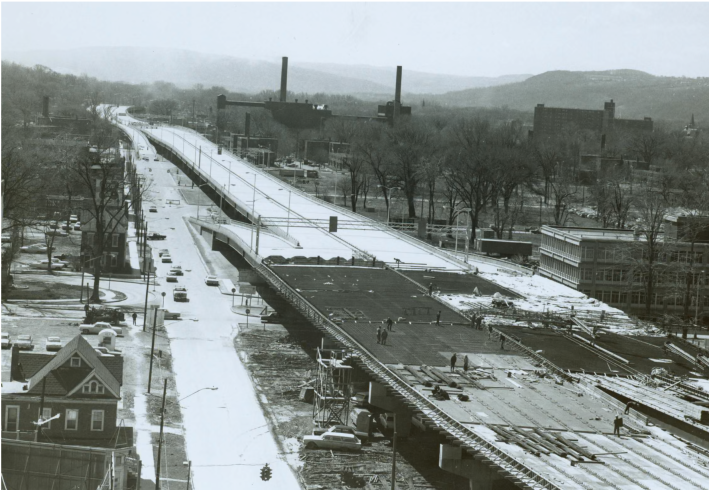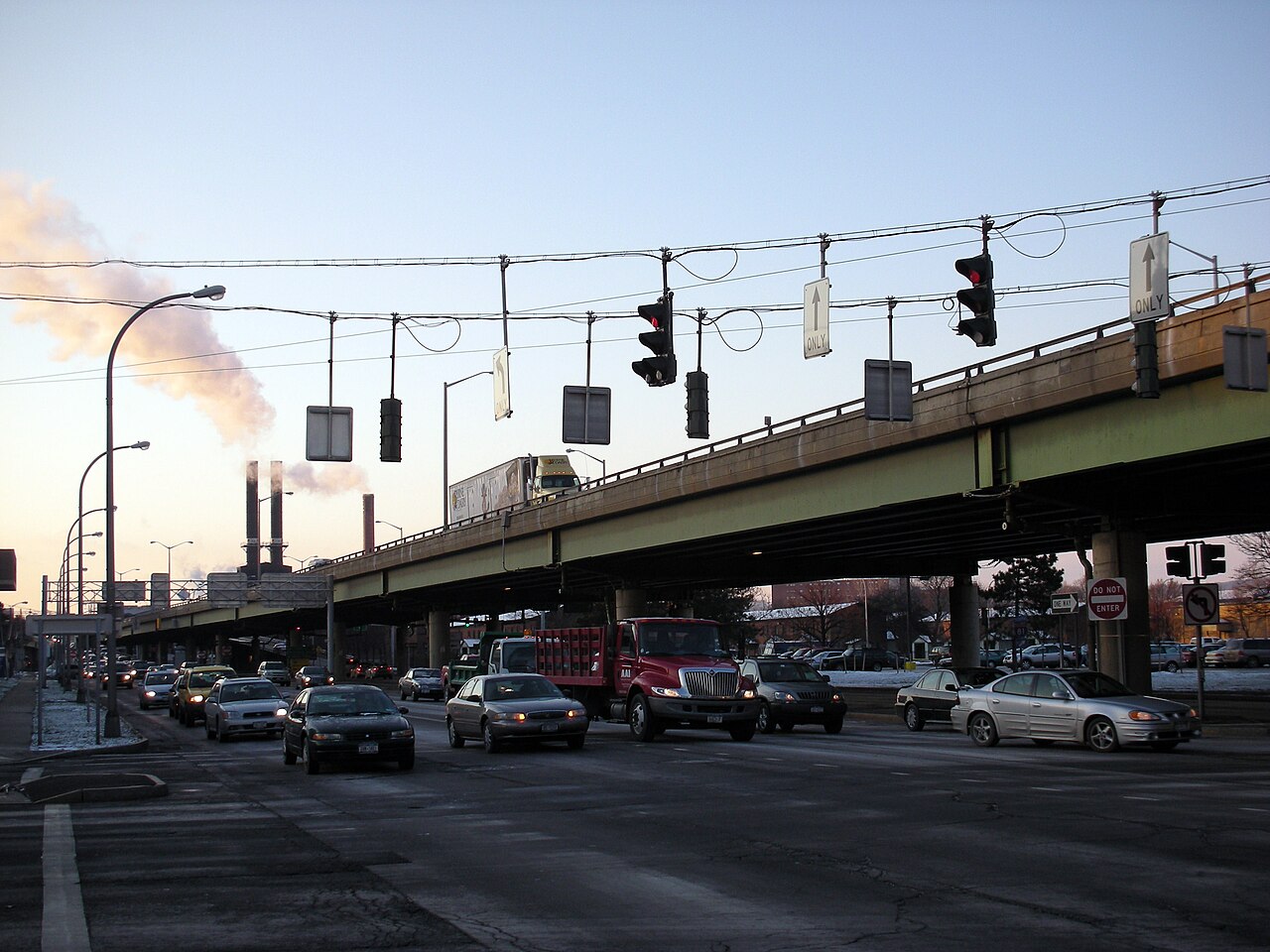Residents in the sprawling public housing complexes in the vicinity of Interstate 81 in Syracuse, New York, are overwhelmed. At the heart of the residents’ confusion – and apprehension – is the coming together of two major infrastructure processes: a massive overhaul of public housing in the footprint of I-81, and the impending teardown of the highway itself.
The two processes are happening in the same corridor but are being run by two different government agencies; the highway project, by the New York State Department of Transportation, and the housing overhaul by the Syracuse Housing Authority. The housing project aims to take down the ancient public housing units and convert the area into a "mixed-income" neighborhood. The I-81 Viaduct Project, meanwhile, aims to tear down the elevated portion of I-81 through downtown Syracuse and reroute it around the city, leaving an at-grade "community grid" in its place.
In the 1960s, the viaduct was constructed through the predominantly working-class Black neighborhood known as the 15th Ward, displacing at least 1,300 families and literally cleaving the city in half for six decades. At $2.25 billion, the teardown will be most expensive project in state DOT history — and, according to Gov. Kathy Hochul, a righting "of past wrongs."
So far, the evidence that the viaduct product will successfully reintegrate a city is encouraging. The teardown has generally proceeded smoothly, undergirded by a comprehensive public outreach process, a clear timeline, and technical innovations that have made the process as undisruptive as is feasible.
But the parallel housing project has run into problems. Residents have been told for years that they must prepare to move when their public housing units are demolished, but then left in the dark without information about when. Others have had to move suddenly, with only the minimum 90-day notice required of their landlords.

Worse, the Syracuse Housing Authority's constantly shifting timeline does not match the Viaduct Project’s work. In fact, some of the residents of the public housing complex known as Pioneer Homes — which is located closest to I-81 — are slated to move last, just as the highway’s construction crews arrive at their doorstep. The lack of clarity has left residents anxious and confused, and public meetings frequently demonstrate how hazy residents are about the distinction — or lack thereof — between the two projects.
Those who haven’t yet been relocated, meanwhile, are also fearful about the dust and debris from the highway teardown, which will contain lead and asbestos. Respiratory disease and lead poisoning rates in the corridor are already amongst the highest in the state, attributable to emissions, runoff, and lead paint chipping from the crumbling viaduct.
The New York State Department of Transportation has assured Syracusans that the dust will be under control during the teardown — but will not actually move any residents who are worried about its health impacts, claiming that its mandate concerns transportation only. When they ask state DOT for help, elderly and immunocompromised public housing residents are redirected to the Syracuse Housing Authority, which understandably musters very little trust amongst the residents to whom the agency has not provided clear answers for years.
It is clear, though, that anxieties around housing and the highway are coming together in a way that overwhelms residents — particularly because the two processes are so deeply uncoordinated. And despite the viaduct project’s admirable progress, some fear its reparative potential may be threatened by the lack of attention to the interlinked fates of housing and highways.

Learning from the past
That linkage, however, is not new – and neither is the alienation of inner-city Black residents near Interstate highways.
In late March 1962, the residents of downtown Syracuse were in many ways facing a similar predicament as they are today. An “urban renewal” program was in full force, and locals were concerned about losing their homes to make way for I-81 as well as the Upstate Medical Center hospital complex. Anxious about the logistics of a sudden, forced displacement, they were looking for assistance with relocation, and struggling to get answers.
When they approached the state, however, they were in for a rude shock: relocation assistance was not being provided for displacement resulting from highway or other major infrastructure construction, only for so-called "slum clearance." Still in the throes of the Civil Rights era, the Black residents of downtown Syracuse were politically disenfranchised and given little formal information on either project to begin with; they were merely told that they would have to leave. And since most were renters, many had no choice but to accept their fate and relocate.
The few homeowners in the area were also struggling to stay. In early March, they’d learned that the state expected them to pay the entire year’s tax for both their existing property – which would be bought by the state under eminent domain – as well as the tax on their future home, whatever it might be, at least if they agreed to a price with the state any time after New Year’s Day. The trauma of losing a home was therefore compounded by the unfairness of having to pay taxes for two.
The utter confusion around relocation, taxes, and future homes increased the burden upon the city’s disadvantaged Black community, whose abysmal housing conditions in the 1950s and '60s were a result of shoddy upkeep by landlords who took advantage of lax code enforcement. Even those who did have the financial means to move were restricted to the 15th Ward area downtown; they were not shown properties elsewhere in the city, because white homeowners were fearful of property values tanking in their neighborhoods.
Lofty promises, uncoordinated execution?
Today’s I-81 project seeks to repair many of those historic harms — and despite its entanglement with the housing project, many advocates do regard it as transformative, even compared to the larger landscape of highway teardowns nationwide.
New York State DOT has been particularly applauded for its meticulous outreach process, in which officials have worked with the county health department to escalate their efforts and inform hard-to-reach residents like the elderly, working single moms, and those without access to the internet. Environmental and health safeguards exceed federal standards, too, and construction has proceeded smoothly and on time. The technical innovations to minimize particulate exposure during the teardown are minor engineering marvels.
That these things are happening against the backdrop of the Trump administration’s disavowal of social and environmental justice objectives has made the project even more important. The City of Syracuse has already lost $30 million of $180 million that it had won under the Neighborhood Access and Equity Program, but the Viaduct Project can continue because its $2.25-billion baseline funding has already, thankfully, been obligated. It is a signature project that stands to reestablish the raison d’etre of teardown projects within a hostile administrative context.
Nonetheless, it is impossible to speak of highways without speaking of housing in Syracuse — especially when residents from the same disadvantaged demographic who lost their homes six decades ago are once again facing confusion and alienation.
To truly address this intergenerational disenfranchisement, today’s highway teardown projects cannot afford to make the same mistakes, despite better intentions. Outstanding future questions on housing, land use, and transit must be answered collectively to ensure that the benefits of teardowns reach those who faced harms in the first place.
In the 1960s, the destruction seen in Syracuse and other cities was only partially attributable to highway-building itself. Most of the trauma was a result of the subsequent search for housing, the confrontation with racist planners and property markets, and the intergenerational poverty that followed the loss of homes and businesses. To maximize their reparative potential, teardowns will also require a coordinated and long-term vision for the city that brings together all levels of government and private enterprise as they plan for new public infrastructure, housing, and commerce.
How might we set up for success? To begin with, a constant, coordinated conversation between transportation departments, housing authorities, and city zoning departments is essential. Moreover, each entity should have a clear idea of the funding lines involved in various development projects – whether it’s public, private, philanthropic, or grant-based. This would offer a more accurate sense of the timelines at play, and permit for coordinated action — even if this lies somewhat outside the natural inclinations of government agencies, which tend to stay within their own "lanes" and focus on executing their projects individually, not collectively.
Finally, and perhaps most importantly, officials heading these intertwined development projects need to choose their words carefully. In painting a rosy picture of a future 15th Ward in Syracuse, for example, Governor Hochul ties I-81 to social justice, renewed business activity, and a more robust, high-quality housing stock populated by diverse, mixed-income residents. While that would be ideal, the reality is that each of these outcomes requires a different set of actions by different actors – and I-81 is only one piece of the puzzle.
On the ground, when residents wander into Viaduct Project outreach centers asking about the construction and redevelopment in the area, they are bewildered when redirected to other agencies, because they’ve always heard housing, highways, and redevelopment all spoken of in the same breath. Consistent messaging across all press conferences, outreach meetings, and documentation can help provide more clarity on the linkages between development projects.
This sort of clarity would require time and a dedication to information-seeking — both of which are in short supply, underwritten by a history of inner-city communities being ignored and actively alienated by government. Setting up expectations through clear, active communication can at least help residents prepare for change while government agencies strengthen coordination. And when the connection between development processes isn’t obvious, answers need to be honest and consistent.
It’s a big promise to redress the harms of interstate construction. Let’s do our best to live up to it.






